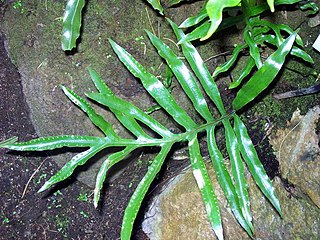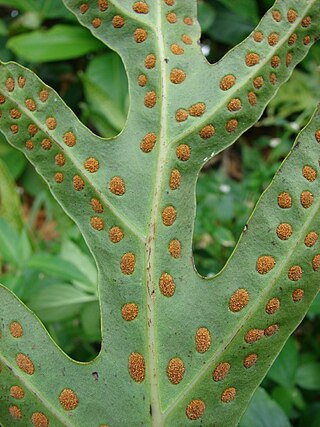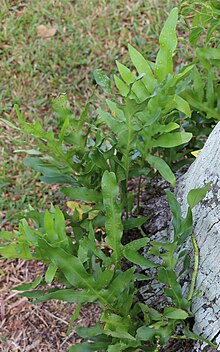
The tree ferns are arborescent (tree-like) ferns that grow with a trunk elevating the fronds above ground level, making them trees. Many extant tree ferns are members of the order Cyatheales, to which belong the families Cyatheaceae, Dicksoniaceae, Metaxyaceae, and Cibotiaceae. It is estimated that Cyatheales originated in the early Jurassic, and is the third group of ferns known to have given rise to tree-like forms. The others are the extinct Tempskya of uncertain position, and Osmundales where the extinct Guaireaceae and some members of Osmundaceae also grew into trees. In addition there were the Psaroniaceae and Tietea in the Marattiales, which is the sister group to most living ferns including Cyatheales.

The ferns (Polypodiopsida or Polypodiophyta are a group of vascular plants that reproduce via spores and have neither seeds nor flowers. They differ from mosses by being vascular, i.e., having specialized tissues that conduct water and nutrients and in having life cycles in which the branched sporophyte is the dominant phase.

This article relates to the flora of New Zealand, especially indigenous strains. New Zealand's geographical isolation has meant the country has developed a unique variety of native flora. However, human migration has led to the importation of many other plants as well as widespread damage to the indigenous flora, especially after the advent of European colonisation, due to the combined efforts of farmers and specialised societies dedicated to importing European plants & animals.

Adiantum, the maidenhair fern, is a genus of about 250 species of ferns in the subfamily Vittarioideae of the family Pteridaceae, though some researchers place it in its own family, Adiantaceae. The genus name comes from Greek, meaning "unwetted", referring to the fronds' ability to shed water without becoming wet.

Lygodium is a genus of about 40 species of ferns, native to tropical regions across the world, with a few temperate species in eastern Asia and eastern North America. It is the sole genus in the family Lygodiaceae in the Pteridophyte Phylogeny Group classification of 2016. Alternatively, the genus may be placed as the only genus in the subfamily Lygodioideae of a more broadly defined family Schizaeaceae, the family placement used in Plants of the World Online as of November 2019.

The Daintree Rainforest, also known as the Daintree, is a region on the northeast coast of Queensland, Australia, about 105 km (65 mi) by road north of Cairns. Whilst the terms "Daintree Rainforest" and "the Daintree" are not officially defined, it is generally accepted that they refer to the area from the Daintree River north to Cooktown, and from the coastline west to the Great Dividing Range. The popular tourist destination of Mossman Gorge, some 30 km (19 mi) south of the Daintree River, is often included in the definition. At around 1,200 square kilometres (460 sq mi), the Daintree is a part of the largest contiguous area of tropical rainforest in Australia, known as the Wet Tropics of Queensland. The region, along with a small number of other rainforest areas on the east coast of Australia, collectively form the oldest continually surviving rainforest communities in the world.

Microsorum is a genus of ferns in the family Polypodiaceae, subfamily Microsoroideae, according to the Pteridophyte Phylogeny Group classification of 2016 (PPG I). The species are tropical. Like most ferns, they grow from rhizomes, rather than roots. The genus name is often misspelled "Microsorium" or "Microsoreum". It includes some species that are lithophytic rheophytes.

Zealandia pustulata is a species of fern native to eastern Australia and New Zealand. It is commonly referred to as kangaroo fern because of its mature leaves tend to resemble the shape of a kangaroo foot. It is also referred to as hound's tongue, and as kōwaowao and pāraharaha in Māori.

Dendroconche scandens, synonym Microsorum scandens, commonly called fragrant fern, is a species of fern within the family Polypodiaceae. This species is native to parts of New Zealand and Australia, as well as some offshore islands. It has been introduced to South Africa and Zimbabwe. An example occurrence in New Zealand's North Island is in the Hamilton Ecological District where it is associated with a number of other ferns including Icarus filiforme and Lomaria discolor.
Kaulinia is a genus of Polypodiaceae, a family of ferns. As of August 2019, it is regarded as a synonym of Microsorum. It was named after Kailas Nath Kaul, an Indian botanist and agricultural scientist. In a morphological study of the sporophytes and gametophytes of several species of Microsorum, it became apparent that at least two phyletically distinct groups of species existed in the genus. The group represented by Microsorum pteropus and Microsorum hancockii seemed to have a different ancestry from the other group, and were placed in a genus known as Kaulinia. The Pteridophyte Phylogeny Group classification of 2016 accepts that Microsorum is not monophyletic, but states that further study is needed. The genus might be recognized in the future.

Zealandia pustulata subsp. howensis, synonym Microsorum pustulatum subsp. howense, is a subspecies of fern, only occurring on Lord Howe Island. The habitat is the shaded forest understorey. It grows from the ground, or on plants or from rocks. Often seen on decaying tree stumps or moss covered rocks.

Microsoroideae is a subfamily in the fern family Polypodiaceae in the Pteridophyte Phylogeny Group classification of 2016 (PPG I). The subfamily is also treated as the tribe Microsoreae within a very broadly defined family Polypodiaceae sensu lato. In either treatment, it includes the previously separated tribe Lepisoreae.

Parapolystichum microsorum, synonym Lastreopsis microsora, known as the creeping shield fern is a common small plant found in eastern Australia and New Zealand. The habitat is rainforest or moist sheltered eucalyptus forests. It may form large colonies. The specific epithet microsora translates to "small sori".
Tasmania is home to 'Australia’s largest cool temperate rainforests. Most of Tasmania’s rainforests occur in the North-West and throughout the North East highlands. Cool temperate rainforests typically have a heavy rainfall, cool climate, favor high altitudes and have a limited availability of light.

Microsorum punctatum is a fern from the subfamily Microsoroideae commonly called the fishtail fern. It has been used in traditional medicine.

Microsorum scolopendria, synonym Phymatosorus scolopendria, commonly called monarch fern, musk fern, maile-scented fern, breadfruit fern, or wart fern is a species of fern within the family Polypodiaceae. This fern grows in the wild in the Western Pacific rim from Australia to New Caledonia to Fiji and throughout the South Pacific to French Polynesia.
Bosmania is a genus of ferns in the family Polypodiaceae, subfamily Microsoroideae, erected in 2019. As of February 2020, the genus was not accepted by some sources.

Dendroconche is a genus of ferns in the family Polypodiaceae, subfamily Microsoroideae, erected in 2019. As of February 2020, the genus was not accepted by some sources.
Bosmania membranacea is a species of fern in the family Polypodiaceae, subfamily Microsoroideae. It is native to tropical and subtropical Asia, from India to Japan and south to Sulawesi.














